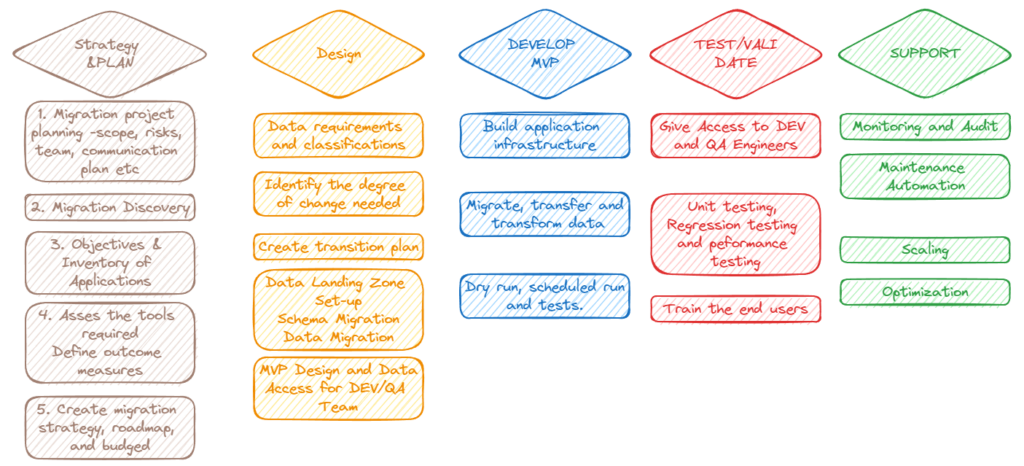Migration from Operational Databases to Cloud-Based Database Services

The transition from operational databases to cloud-based database services like AWS, GCP, and Microsoft Azure has become a critical step for many organizations aiming to enhance scalability, security, and cost-efficiency. This shift is transforming the data infrastructure landscape, allowing businesses to achieve sustainable growth in an increasingly digital era. As a Senior Data Engineer Consultant, I have witnessed firsthand the advantages and challenges of such migrations. This blog post will delve into the essential steps and considerations for successfully migrating from operational databases to cloud-based services.

Why Migrate to Cloud Databases?
In previous post, we highlighted the significant benefits of moving to cloud databases. These include enhanced scalability, improved security, cost efficiency, and simplified data management tasks like backups. Cloud databases offer a robust platform for handling the dynamic needs of modern businesses, making them a preferred choice for startups and mid-sized companies.
Steps for Migration
The migration process can be complex and challenging. The attached image outlines a comprehensive migration plan that can guide organizations through this transition. Here’s a detailed breakdown of each step:
- Strategy & Planning
- Migration Project Planning: Define the scope, risks, team structure, and communication plan.
- Migration Discovery: Identify existing data sources, workflows, and dependencies.
- Objectives & Inventory of Applications: Clarify the goals of migration and catalog all applications involved.
- Assess the Tools Required: Evaluate and select the tools needed for migration.
- Create Migration Strategy, Roadmap, and Budget: Develop a detailed strategy and timeline for the migration process.
- Design
- Data Requirements and Classifications: Determine data requirements and classify data based on sensitivity and usage.
- Identify the Degree of Change Needed: Assess how much change is required in data structures and workflows.
- Create Transition Plan: Develop a plan for transitioning from the old system to the new one.
- Data Landing Zone Setup: Establish the initial environment in the cloud.
- Schema and Data Migration: Plan for migrating database schemas and data.
- MVP Design and Data Access for DEV/QA Team: Design a minimum viable product and ensure development and QA teams have access.
- Develop MVP
- Build Application Infrastructure: Set up the necessary infrastructure in the cloud.
- Migrate, Transfer, and Transform Data: Move data from the old system to the new one, applying necessary transformations.
- Dry Run, Scheduled Run, and Tests: Conduct test runs to ensure everything works as expected.
- Test/Validate
- Give Access to DEV and QA Engineers: Ensure development and QA teams can access the new system.
- Unit Testing, Regression Testing, and Performance Testing: Conduct thorough testing to ensure the system functions correctly.
- Train the End Users: Provide training for end-users to facilitate the transition.
- Support
- Monitoring and Audit: Continuously monitor the system and conduct audits to ensure data integrity.
- Maintenance Automation: Automate maintenance tasks to reduce manual intervention.
- Scaling: Scale the system as needed to handle increased workloads.
- Optimization: Continuously optimize the system for performance and cost efficiency.
Key Considerations During Migration
- Ensure Existing Functionality: Ensure that essential functionalities of the old platform are replicated or improved in the new system to avoid disruption.
- Collect Requirements from Data Engineers: Engage with end-users to understand their needs and challenges with the current platform.
- Data Migration: Carefully plan the data migration process, ensuring data consistency and minimal downtime.
Conclusion
Migrating from operational databases to cloud-based database services is a strategic move that offers numerous benefits. However, it requires careful planning, execution, and continuous monitoring. By following the outlined steps and considerations, organizations can successfully navigate the complexities of migration and leverage the full potential of cloud databases.
If you have any questions or need assistance with your data migration project, feel free to reach out. As experienced data engineers, we are here to help you achieve a seamless transition and unlock the advantages of cloud-based data solutions.
business analytics Cloud Data Data Consulting Data Migration